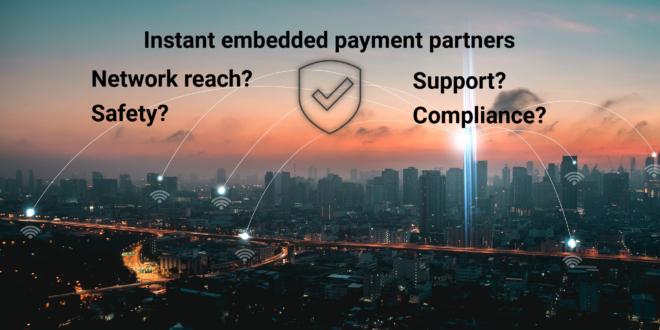By Drew Edwards, Founder and CEO of Ingo Money
We are fast moving towards a digital money world. According to Euromonitor estimates, cash and check payments will make up just 14% of total payments this year, down dramatically from 42% in 2020.
The pandemic played a part in this, but so has the growth of fintech-adjacent industries. Sectors like gaming, restaurant & hospitality, real estate and more are rapidly adding payment capabilities to their core product experience. Think of instant payouts for mobile casino apps or digital tip disbursements.
Today, embedded payments are the new normal. But companies must be hyper-vigilant about how they roll out these services to maximize the upside and minimize the risk.
Rise of Instant in Embedded Payments

Amongst embedded payment features, instant funding stands out as the clear preference for consumers. Like with nearly every other digital experience, they want their money to flow instantly and safely anywhere they choose at the press of a button.
According to a recent report, the number of consumers who said they had received at least one instant disbursement continues to grow, increasing 10% over 2022. Their preference for instant payments is also at an all-time high, with 47% of consumers saying they would opt for an instant disbursement if it were available.
But sending money instantly is not as simple as sending a video or a meme. To enable true instant money mobility is a complex and regulated endeavor. A simple API-only solution won’t cut it.
Companies should consider these four key criteria to find the right provider in this complex, high-stakes world of embedded payments.
Network Reach

Money mobility is defined by the ability to send or receive money into any consumer account. To truly deliver on this promise, companies must identify embedded payment vendors that give them the furthest reach possible into the billions of available consumer accounts across credit and debit cards, online wallets, bank accounts and more. For those companies that market consumer choice, limiting which accounts a customer can fund or receive money in is shortsighted.
Generally, payment providers frame their network reach in terms of gateways or endpoints. Look for those that span networks to avoid being locked into funding only accounts handled by Visa or Mastercard, for example. And ask probing questions to ensure that providers are constantly maintaining and nurturing these endpoints, as they do require upkeep to remain connected and live.
Compliance

Few companies are prepared to navigate the complex world of regulations and compliance that embedded payment solutions require. Even contemplating the things like in-line sanctions screening and clearing, account-level velocity monitoring, and dynamically managed workflow and session clock management required to comply with banking, financial and jurisdictional regulations can be daunting.
These critical regulations ensure that all money movement in the US is between legitimate parties for legitimate purposes and that private and sensitive data is protected and secure. Even simple errors in how a company sets up its accounts or whether they hold money on its books can run afoul of things like money transmission or information security regulations and standards.
It pays companies to evaluate embedded payment vendors by their compliance support offerings. Look for a provider that can help assess current compliance flows, create custom options based on a specific industry, and be available for ongoing support needs if they arise. Being caught flat-footed by regulators is every company’s worst nightmare and can lead to substantial fines and judgments down the road.
Partner Support

Encountering an issue with a payment is inevitable, regardless of the provider. For example, consider if an insurance customer reports non-receipt of a digital payout from their claim after an accident. If a brand experience hinges on a fast payout, this can be the difference between earning a customer’s loyalty or losing them to a competitor.
Companies need a partner that will immediately troubleshoot in real time to obtain proof of payment, identify why it was unsuccessful (if it did not post), and then resolve the problem to the satisfaction of both the client and the end customer. Look for providers that offer multi-channel support options and that are available 24/7. If a brand’s value proposition involves an anytime, real-time payment, it can’t afford a partner operating on bankers’ hours or by email only.
Risk
Risk controls are paramount for any transaction involving money and will be required by participating sponsor banks. The essential elements involve security for sensitive data, controls and real-time governors to reduce exposure and proper authentication tools to ensure funds are paid to the right person.

The key to choosing an embedded payments partner is to identify a platform with a long track record of trust, scale and success with significant enterprises and banks. Unfortunately, many providers are developer-first or developer-only shops that can make the tech or connectivity look easy but are often unprepared to help control the risk of moving billions of dollars.
For example, mitigating against disbursement fraud requires that risk controls like digital identity verification and account ownership validation are performed according to a company’s internal, custom-configured risk rules. In this way, companies can make sure they pay who they intend.
The right mix or prioritization of each of these four criteria will vary for each company. The industry within which it operates, the nature of its solutions, and its internal resources will all factor into the decision.
The key is to balance these criteria to deliver seamless payments. As with any embedded solution, a brand needs a partner to ensure its customers never notice a difference from other aspects of its business. By making payments a seamless, embedded experience, a company can leapfrog the competition and earn long-term loyalty and revenue from its customers.
About the Author

Drew Edwards is the CEO of Ingo Money. He is widely regarded as an authority on instant payments, having led the creation and commercialization of multiple innovative payment technologies at Ingo, and he regularly writes, speaks and is cited as an expert on the topic.
Recent PaymentsNEXT news:
Treasurers embrace modern payments, but old methods die hard

